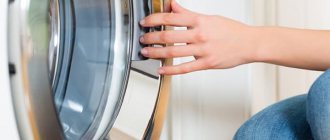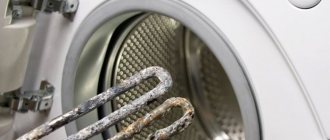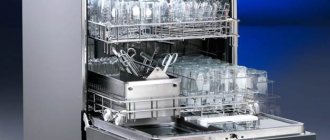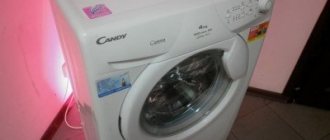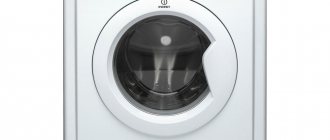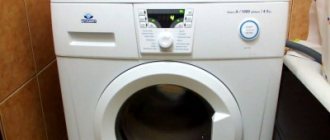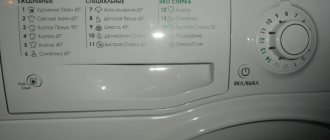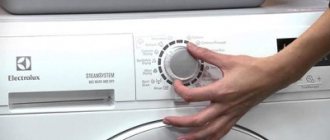Caring for your automatic washing machine is the key to successful washing. If you don't take care of it, you can face serious consequences - machine breakdown.
If you have just purchased a machine, it is recommended that you read the instructions before using it, where you will find useful operating information. If you follow these recommendations, a long service life is guaranteed. And in this article we will tell you how to properly care for SM.
What is machine care?
All of the recommendations below apply, by and large, to automatic washing machines. Some of them can be used for other washing machines, but they, in all likelihood, will soon become a rarity, so it is better to focus on the first ones, because the future lies with them.
- The main thing in caring for any household appliance is to ensure cleanliness, and for this it needs to be washed frequently. This is required by both safety conditions and basic hygiene, which is simply necessary in the house. Dust and dirt accumulate various microorganisms, including pathogenic ones, which can cause various ailments in those living in this room. Regular citric acid can help here. It will clean the device and remove excess odors.
- The surface of the device must be free: no objects, powders, or dishes should be placed on it. The top panel should be dry and clean.
- It is important to monitor the drain pipeline for possible leaks. For this purpose, you can install multi-level protection.
See also -
How to clean an automatic washing machine with vinegar to remove scale and unpleasant odors?
Internal descaling of the washing machine
To prevent scale from accumulating and causing problems in the operation of the device, it is necessary to periodically carry out internal cleaning. A variety of modern means can be used for this. For example, to combat scale during washing, it is recommended to add “Antiscale”.
But various folk remedies are no less effective:
Cleansing with vinegar
Simple acetic acid can be used to clean the washing machine from various types of contaminants. The cleaning procedure is carried out according to the following scheme:
- You will need to take approximately 2 tbsp. l. acetic acid (acetic essence).
- The product is slowly poured into the device - directly into the drum.
- The machine turns on and the long-term wash mode is set.
- The washing temperature is set to the highest possible level, making the procedure more effective.
- The machine must operate for at least 5 minutes in the set mode.
- After this time, “pause” is pressed, but the acetic acid is left inside the device for an hour. This time will be enough for the product to dissolve existing contaminants, but without causing harm to the machine parts.
- After the specified time has elapsed, the washing mode ends.
- The remaining acid is removed from the machine, but to completely remove it, it is recommended to do a short wash.
- At the end of the cleaning procedure, all internal parts must be rinsed with plenty of clean water and wiped with a dry cloth.
- Don’t forget to wipe the rubber seal, as well as the inside of the door. To do this, it is recommended to use a solution consisting of water and vinegar (the components are taken in equal quantities).
When performing this cleaning method, it is prohibited to use any additional detergents.
Lemon acid
Using citric acid helps clean the washing machine from unpleasant odors, mold, limescale and dirt residues. But for this you need to use only fresh product. The procedure itself is performed in the following way:
- You will need to take at least 200 g of citric acid.
- The product is poured into the washing powder tray or directly into the drum of the machine.
- The device turns on, the long-term washing mode is set, and the temperature should be at least 60 degrees.
- The active substances of citric acid have an intense destructive effect on the structure of limescale. As a result, it peels off easily and quickly from the internal surfaces of the machine.
- As soon as the washing program is completed, the rinse cycle starts, which removes any remaining citric acid.
- It is recommended to carry out this procedure for cleaning an automatic washing machine no more than once every 3 months.
It is strongly recommended not to use citric acid too often to clean household appliances, as this can cause early wear of rubber parts.
Cleansing with baking soda
If dirt has accumulated inside the washing machine, it is recommended to use simple baking soda, which is found in every home, to remove it. This product effectively cleans the drum walls and does not harm the device. The cleaning procedure is carried out according to the following scheme:
- Take equal amounts of clean water (room temperature) and baking soda.
- All components are thoroughly mixed, as the soda crystals must completely dissolve.
- Take a sponge, soak it in the resulting cleaning composition and wipe the surface of the drum.
- Remains of the product must be washed off with plenty of clean water.
- You need to wipe both the metal parts of the machine and the rubber ones, because dirt also accumulates on their surface.
- Once the remaining soda solution has been removed, wipe the treated surfaces dry with a clean cloth.
Soda is often used to clean washing machines, because with its help you can remove not only dirt, but also mold. It is recommended to carry out this procedure once every 7 days, regardless of whether the device is in use or not.
Correct installation and connection of the washing machine
Caring for your washing machine begins with its proper installation. It is necessary to take into account that it must stand perfectly level, so to complete this point it is advisable to take a level for construction work. Tilts can be eliminated using legs, the height of which can be easily adjusted. For this purpose, you just need to lift the edge of your washing machine and scroll the leg to the desired length.
It is necessary to check that the wires, drain and inlet hoses are not bent or pinched by various objects or the machine itself. If the wires are bent, their insulation may be damaged, and it may even break. As for the hoses, disruption of their patency creates obstacles to the normal filling and draining of water.
Pollution prevention measures
A well-known truth: it is easier to prevent than to eliminate the consequences. This also applies to washing machines. To ensure that your automatic machine is always in order, it is enough to follow a few simple recommendations.
- Do not store dirty laundry in the machine's loading tank.
- Empty the drum of washed clothes immediately after the end of the cycle.
- After each cycle, wipe the automatic machine dry, having first disconnected it from the power supply.
- Leave the door open after each wash for ventilation.
- Remember to periodically clean the heating element, drain filter and hose.
- Place the washing machine in a well-ventilated, dry area.
How to care for parts inside the car
- The car should be maintained both outside and inside. All departments and compartments of the machine need our care. It is important to keep the dispenser clean. It is a plastic tray into which powder and other washing substances are poured. It's very easy to get. It is imperative to monitor the cleanliness of the dispenser, otherwise the drain holes may become clogged with powder residues, which subsequently turn into stone deposits.
- After washing, the hatch is opened slightly and left open for a while to allow all the moisture to evaporate. If you do not do this, an unpleasant odor will appear inside the washing machine.
- Before putting things into the drum, you need to check all pockets for foreign objects, such as keys and rings and other small items that could cause damage to the washing machine. All laundry that has metal fittings, such as rivets, buttons and zippers, must be turned inside out before washing or use a special bag.
- Caring for your washing machine includes washing all its components. This also applies to the cuff - a rubber layer that is located near the drum and the hatch. To treat it, use a warm soap solution; it is not allowed to wash the cuff with detergents.
- Do not load more than the maximum permissible weight into the device. The instructions should indicate the weight allowed for washing. It is worth considering that the calculation is not based on dry weight; most often, the permissible amount of wet laundry is indicated!
- To prevent mold and unpleasant odors from appearing, you need to regularly clean the drain filter. It is located at the bottom of the washing machine. It can collect various objects, buttons, hair, coins. If this compartment is not cleaned, your items may develop a musty smell. If you take timely care of this part of the machine, then such a problem will not arise.
External surfaces of the washing machine
Expert opinion
I work in the household appliance repair industry. Extensive experience in restoring washing machines and dishwashers.
Ask a Question
The washing machine body should be kept clean. To rid external surfaces of contamination, you first need to disconnect the equipment from the power supply.
Then use a damp sponge or soft cloth soaked in detergent to wipe all panels of the machine. After removing dirt, wipe the surfaces with a dry cloth.
This procedure should be carried out once a week. Remember that:
- It is necessary to avoid getting moisture on the machine. This may cause corrosion or even a short circuit. It is better not to place the washing machine near water sources.
- It is important to monitor the integrity of the hoses and electrical cables and avoid kinks or creases.
Body of a disassembled washing machine
How to check water quality
The operation of the washing machine is affected by the quality of water. Hard water causes scale build-up, which can negatively affect the heating element. It is for this reason that the washing machine may break down. Water hardness can and should be combated. How to determine water hardness? Most Russian citizens don’t have to do this, since the water from our water pipes is far from the standard of quality. If you still have doubts, you can determine the hardness using special test strips, which can be purchased at a household chemical store.
Biocare
The bio-care or bio-wash function, which some modern washing machines are equipped with, is based on the use of detergents with enzymes. These active components remove food and other stains well and perfectly refresh linen.
Since enzymes are destroyed at high temperatures, bio-care involves a long wash in low-heat water. The result is excellent: the dirt is washed away, the laundry smells fresh and clean.
But bio-care is a rather expensive way to clean clothes, since powders with enzymes are not cheap, and due to the increase in washing time, the consumption of water and electricity increases.
Fighting water hardness
All channels broadcast advertisements about various water softening additives. You can choose its brand at your discretion. Most of these products are very expensive. But you can use more economical options.
Among such completely harmless and cheap remedies is citric acid. It will help get rid of scale in the machine. To do this, you should take about two hundred grams of it. Citric acid should be poured into the department intended for powder. Then set the highest possible temperature (most often it is 80-90 degrees).
Before cleaning the washing machine with citric acid, you should check if there are any things in the device. Citric acid can ruin things. At the end of washing with citric acid, wipe the drum and all folds of the cuff with a soft rag. Scale particles are often found inside the appliance. They are carefully removed. The washing machine will be grateful for such “lemon” cleaning.
To make water softer, you can use different softening filters. High-quality filters are expensive, but they can purify water for the entire home.
The most important rule: read the instructions
If the washing machine is a new appliance in your home, take the time to look through the instructions for it. If you leave this small document without attention, you may never learn about a number of useful functions of the machine. For example, the Miele W 2859 iR WPM ED built-in washing machine has a unique “Especially quiet wash” option, which can only be studied in the instructions. Another advantage of this model is the ability to wash pillows (this is also written in the instruction manual).
By following these simple rules, you can extend the life of your washing machine for many years. It is not for nothing that manufacturers, when promising us an impressive service life of such equipment, always add the note: “With proper use.”
Useful tips
You can extend the life of your washing machine if you follow these recommendations:
- Use only special “automatic” washing powder.
- You should not keep dirty clothes in the washing machine; you should put them only before washing, otherwise an unpleasant odor will appear in the device;
- Wash colored and white items separately.
- If you need to leave for a long period of time, all devices must be disconnected from the power supply. The water also needs to be turned off.
On average, an automatic machine lasts from seven to ten years. Most often, the reason for its failure is the lack of proper care. Proper care of your automatic washing machine, regular cleaning with at least citric acid, compliance with all necessary operating conditions, then its service life can be doubled.
I am myself!
Some modern models of washing machines have a self-cleaning drum function. It cleans the loading tank from debris, wool, hair, threads, etc. that settles during washing. and resembles the idle wash mode.
- A preliminary cleaning stage is activated, similar to a pre-wash.
- After the preparatory stage, the cleaning itself begins, during which the drum rotates at a speed of 50–150 rpm, and the water warms up to 60 0.
- The last step is to rinse, usually twice, and spin at maximum rpm.
The whole procedure takes about one and a half hours. It must be done at least once a month. Of course, the presence of this quality affects the price of the electrical appliance. But the same familiar master, sharing his experience, revealed a secret: this option can be successfully replaced by timely and thorough care.
Causes of dirt formation
The paradox is that the purpose of the machine is to clean our things, but at the same time the unit itself is extremely sensitive to the dirt accumulating inside. Sometimes even the slightest deviation from sterility leads to breakdown.
IMPORTANT! Most often, the internal elements of the device accumulate dirt, which comes off clothes during washing. Constant dampness and musty air lead to the formation of fungus and mold on the rubber seal and the edges of the drum.
One of the most important elements in a washing machine, the heating element (heating element), also suffers from contamination. All the scale and deposits remaining from salts collect on it (especially if the water is hard).
Sources of washing machine contamination:
- increased water mineralization;
- the use of aggressive household chemicals, as well as low-quality laundry preparations;
- improper use or care of the device;
- Frequent washing of excessively soiled items (for example, clothes with residues of mortar, machine oil, paint, etc.).
